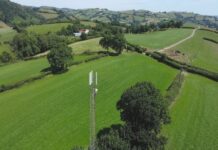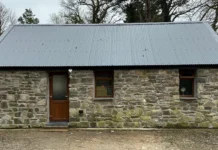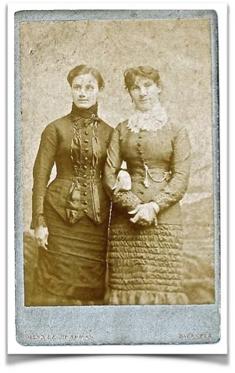History of Llanelli: Llanelli Dock Railway
The original Llanelly Dock Company was formed by a group of local businessmen who had interests in the Llangennech Coal Company. Previously the coal was transported by small barges or the newer tramroad to wharves on the mouth of the Loughor river at Yspitty Bank where it was stored before loading onto larger sea-going vessels.
It was with the prospects of developing the Llangennech coal seams in the Dafen district of Llanelli that a pit was planned by the Llangennech Company. A two mile (3Â km) line would connect with the company’s New Dock on Llanelli Flats, with a rope operated incline at the Dafen end to the new St. David’s Pit. The Act authorising the construction of the line and dock received the royal assent on 19 June 1828. Problems with the pit delayed the opening of the railway until 1833.
The line managed to survive for well over a century and was known simply as the Dafen Branch when it closed in 1963. Some of the route can still be traced. A portion forms a footpath from Trostre Road towards the mainline behind the Llwynw
 hilwg housing estate whilst a stretch of the M4 link road, which connects Halfway and Dafen is built over the trackbed.
Â
In August 1835 the Llanelly Company took on the grander title of the Llanelly Railway and Dock Company. As the change of title suggests the company was to concentrate on its railway business. It obtained powers to build a line from its dock via the west bank of the Loughor river to Llandeilo with various branches along the way.
The first stretch of 6Â miles (9.7Â km) opened on 1 June 1839 and probably made use of some of the trackbed of the Llangennech tramroad near Yspitty Bank, which by that time had fallen into disuse.
By early 1840 a further 10¾ miles of track to Cwmamman (later named Garnant) had opened. Nearly 5 miles (8.0 km) of this section formed the mainline to Llandeilo with the remainder being the branch to Garnant. The line served an area where the bulk of traffic was expected to be anthracite coal for export.
Steam introduced
The first train out of Cwmamman ran on 10 March 1840 and so established the Llanelli line as one of the oldest. The original Dafen line had used horses but the new line was to use two steam locomotives. They had been due for delivery in September and December 1839 in readiness for the opening of the new line but the Company had to continue the use of its horses because neither engine arrived in time to haul the first train.
In May 1840 the belated locomotives, named Victoria and Albert were put to work.
Extensions
On 6th May 1841 the mainline was extended by a further 1.25Â miles (2Â km) to Duffryn (renamed Tirydail in 1889) and a further branch was opened to Crosshands.
This line included two rope worked inclines, one of which was a mile long. This branch survived until 1964. About this time the Cwmamman branch was extended to Gwaun-Cae-Gurwen. This section closed during the General Strike of 1926. In June 1842 the branch from Cwmmawr to Brynamman opened and continued in use until December 1963 although passengers had not been carried since 18th August 1958.
By the end of 1842 the single track railway totalled some 28.25Â miles (45.5Â km) – 12Â miles (19Â km) of the route was the mainline with the rest made up of several branches. On 1st January 1858 the Llandeilo to Llandovery section was opened.
This line was built as a separate undertaking, bearing the title Vale of Towy Railway, but was leased to the Llanelly Company from the beginning. With this 11-mile (18Â km) extension, the Llanelly Railway totalled 46Â miles (74Â km).
The Llanelly Railway (New Lines) Act of 1st August 1861 authorised the Company to extend its routes further with two additional routes. The first to open was the line from Llandeilo to Carmarthen. The first goods train used the line on 14th November 1864 and passenger traffic began on 1st June 1865. The line provided attractive views of Dynevor and Dryslwyn Castles and Paxton Tower. The single line was 13.25Â miles (21.3Â km) to Abergwili Junction just north of Carmarthen where a third rail was laid on the four year old broad gauge line of the Carmarthen and Cardigan Railway, providing mixed gauge access to the station. The line was built as an alternative to the Great Western Railway (GWR) mainline along the coast and at its opening a special excursion fare of 2 shillings (10p). This line closed on 7th September 1963.
This line was built as a separate undertaking, bearing the title Vale of Towy Railway, but was leased to the Llanelly Company from the beginning. With this 11-mile (18Â km) extension, the Llanelly Railway totalled 46Â miles (74Â km).
The Llanelly Railway (New Lines) Act of 1st August 1861 authorised the Company to extend its routes further with two additional routes. The first to open was the line from Llandeilo to Carmarthen. The first goods train used the line on 14th November 1864 and passenger traffic began on 1st June 1865. The line provided attractive views of Dynevor and Drislwyn Castles and Paxton Tower. The single line was 13.25Â miles (21.3Â km) to Abergwili Junction just north of Carmarthen where a third rail was laid on the four year old broad gauge line of the Carmarthen and Cardigan Railway, providing mixed gauge access to the station. The line was built as an alternative to the Great Western Railway (GWR) mainline along the coast and at its opening a special excursion fare of 2 shillings (10p). This line closed on 7th September 1963.
The second line was a branch from Pontardulais to Swansea with a further branch off that line at Gowerton to Penclawdd. The route took the line through Gorseinon, Gowerton (South Station), and then to the seashore at Swansea Bay via the Clyne Valley.
Here the line ran between the seawall and the Oystermouth Railway to a new terminus called Swansea Victoria. The Act had provided for part of the Oystermouth Railway’s trackbed to be realigned. The parallel turnpike road was also moved.
The line opened in January 1866 but a shortage of funds left the passenger terminus incomplete so that only goods were carried. It took until 14th December 1867 before Swansea Victoria station saw its first passengers.
This date also marks the Llanelly Railways peak of development with a total of just over 72 route miles, including the Vale of Towy line. The route of the line from Swansea Victoria (on the site of Swansea Leisure Centre) to Dunvant can be easily traced as it forms the promenade and cycle track giving an excellent opportunity to explore the Clyne Valley. Other parts of the route can be traced at Gowerton, Gorseinon (roads have been built along the trackbeds at both these places) and Penclawdd.
Legal issues
The Llanelly Company, however, made the mistake of not renewing its right to the lease of the Vale of Towy line so that it had been forced to make a joint agreement with the Central Wales Railway in May 1868.
The London and North Western Railway (LNWR) were involved with this and other companies who built the northern section of the central Wales route and gaining running powers to Llandeilo helped their overall plan to reach the South Wales coast and break into GWR territory. The completed Central Wales line was opened in June 1868. The Llanelly Railway were to discover that the LNWR would be a significant factor in their final demise.
In 1873 an Act authorised the Llandeilo to Carmarthen and Llandeilo to Swansea sections to become a separate company, to be called the Swansea and Carmarthen Railway. The LNWR had been granted running powers over the Swansea and Carmarthen lines since 1st July 1871 but a dispute arose over payments for these rights.
The Llanelly Company eventually approached the House of Lords to cancel the agreement. The LNWR responded by seeking to take over these lines entirely. The LNWR claimed that the Llanelli line had achieved its importance only because of the development of the Central Wales route. This argument convinced Parliament and the Carmarthen and Swansea undertakings were transferred to the LNWR in 1873, with the Llanelly Company retaining running powers over its own ex-line. The Company now reverted to its 1857 mileage of 35Â miles (56Â km). From 1st January 1873 the GWR took over the operation of the remaining section, running passenger trains to Llandovery as a branch from Llanelli – an arrangement which continued until 1964 when the steam hauled services ended.
Recent times
From the summer of 1964 a diesel multiple unit service started at Swansea (High St) and travelled along the mainline to Llanelli before reversing to join the Central Wales line at Llandeilo Junction, the arrangement that exists to this day. At the same time Swansea (Victoria) closed to passengers.
For more information and pictures please visit http://www.87f.co.uk/index.html. 87F is a site dedicated to the Railways in Llanelli.
Llanelly Railway and Dock Company
Help keep news FREE for our readers
Supporting your local community newspaper/online news outlet is crucial now more than ever. If you believe in independent journalism, then consider making a valuable contribution by making a one-time or monthly donation. We operate in rural areas where providing unbiased news can be challenging. Read More About Supporting The West Wales Chronicle























